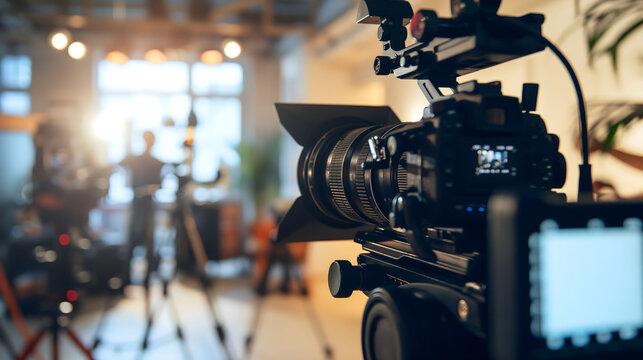Video Production Equipment








Video Production Equipment
Producing high-quality video content requires the right tools and equipment to capture professional visuals and audio. Here is an overview of essential video production equipment, including cameras, lighting, and sound gear, along with why they’re important:
1. Cameras
- DSLR and Mirrorless Cameras: These cameras offer great image quality and interchangeable lenses, making them popular for many video creators. They are versatile, portable, and produce cinematic video footage with shallow depth of field.
- Examples: Canon EOS R5, Sony A7S III, Panasonic GH5.
- Cinema Cameras: For more advanced projects, cinema cameras provide superior image quality, dynamic range, and color grading options. They are built specifically for filmmaking.
- Examples: Blackmagic URSA Mini Pro, RED Komodo, ARRI Alexa Mini.
- Action Cameras: Compact and rugged, action cameras are designed for capturing immersive, on-the-go footage. They excel at extreme sports and high-motion shots.
- Examples: GoPro HERO series, DJI Osmo Action.
- Smartphones: High-end smartphones can shoot impressive video, especially with added accessories like stabilizers and external lenses. They are great for quick projects, social media content, and mobile journalism.
- Examples: iPhone Pro series, Samsung Galaxy S series.
2. Lenses
- Prime Lenses: Offer superior sharpness and low-light performance. Common focal lengths include 35mm, 50mm, and 85mm for different framing needs.
- Zoom Lenses: Provide flexibility in framing without changing lenses. They’re practical for dynamic shoots where repositioning isn’t possible.
- Specialty Lenses: Such as wide-angle, macro, or telephoto lenses for specific creative shots.
3. Stabilization Equipment
- Tripods: Essential for steady shots and interviews. A tripod allows for smooth panning and tilting.
- Gimbals: Handheld stabilizers that use motors to provide smooth movement, perfect for capturing cinematic motion shots while walking or moving.
- Examples: DJI Ronin, Zhiyun Crane.
- Sliders and Dollies: Allow for controlled, smooth movements along a fixed path, adding production value to shots.
4. Lighting Equipment
- LED Panels: Lightweight and energy-efficient, LED panels are popular for their versatility. They can be adjusted for brightness and often offer variable color temperatures.
- Examples: Neewer LED panel, Aputure Amaran series.
- Softboxes and Diffusers: Used to soften light, reducing harsh shadows and creating a more even and flattering appearance on subjects.
- Ring Lights: Often used for vlogging, interviews, and beauty videos. They provide even, soft light directly on the subject’s face.
- Key Light, Fill Light, and Backlight Setup: A three-point lighting setup ensures depth and dimensionality in shots, creating a professional appearance.
- Light Reflectors: Inexpensive but effective tools to bounce light onto a subject, useful for adjusting natural lighting or filling shadows.
5. Sound Gear
- External Microphones: Good audio is as crucial as good visuals. On-camera mics are often inadequate for professional sound quality.
- Shotgun Microphones: Ideal for capturing directional audio with minimal background noise. Often mounted on booms or camera rigs.
- Lavalier (Lapel) Microphones: Small, clip-on mics suitable for interviews, presentations, and hands-free speaking roles.
- Handheld Microphones: Commonly used for on-the-spot interviews and reporting.
- Audio Recorders: Used for recording higher-quality audio externally when connected to microphones. Examples include the Zoom H4n and Tascam DR-40.
- Windshields and Pop Filters: These accessories reduce noise from wind or harsh plosives when recording vocals, improving audio clarity.
- Headphones: High-quality monitoring headphones are essential for accurately assessing sound quality during recording and editing.
6. Accessories
- Memory Cards: High-speed and high-capacity cards ensure that video can be recorded without buffering or data loss.
- Batteries and Chargers: Extra batteries and portable chargers help extend shooting time, especially during location shoots.
- Cables and Adapters: Reliable HDMI, XLR, and power cables, as well as adapters, are necessary for connecting equipment.
- Camera Bags and Cases: Protective gear for transporting and storing equipment securely.
7. Editing and Post-Production Tools
- Computers and Editing Software: Video editing requires a computer with sufficient processing power and memory, as well as editing software like Adobe Premiere Pro, Final Cut Pro, or DaVinci Resolve.
- Monitors and Calibration Tools: A color-accurate monitor ensures that what you see during editing represents what the audience will see.
Tips for Choosing Equipment
- Start with the Basics: Focus on a high-quality camera, good lighting, and sound before expanding into specialized gear.
- Consider Portability: For mobile shoots or frequent travel, prioritize lightweight, portable options.
- Match Equipment to Content: Identify the specific needs of your projects (e.g., interviews, action shots, cinematic storytelling) and choose gear accordingly.
- Budget Wisely: High-end gear isn’t always necessary. Determine what delivers the most impact for your video goals without overinvesting.
Conclusion
Having the right video production equipment allows creators to produce professional and engaging content. While high-quality visuals are critical, good lighting and sound play an equally important role in creating a polished final product. Tailoring your equipment to your specific needs and budget ensures you get the best results possible for your projects.

